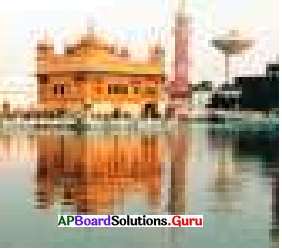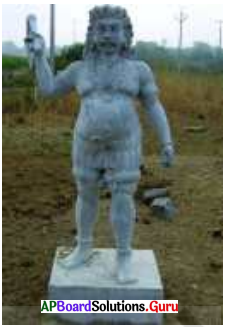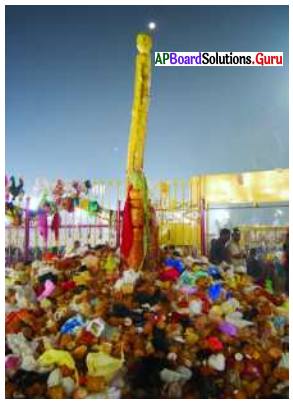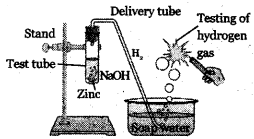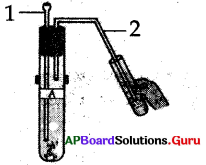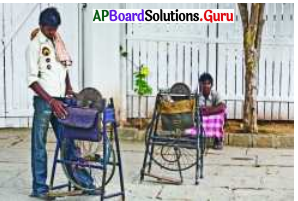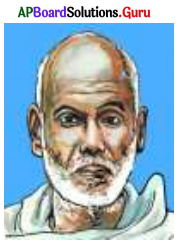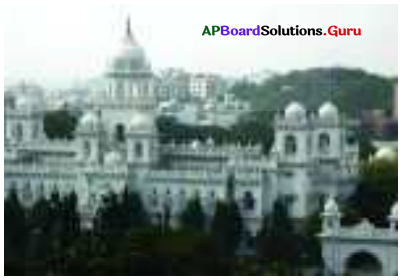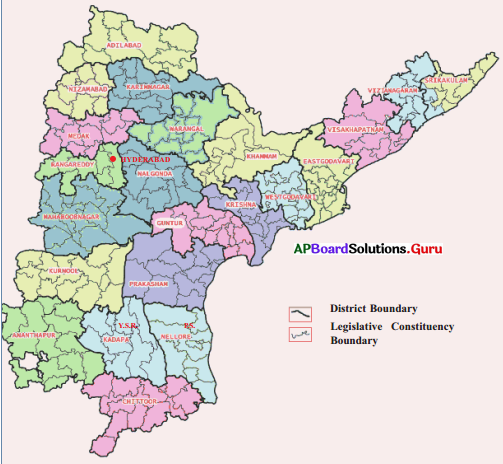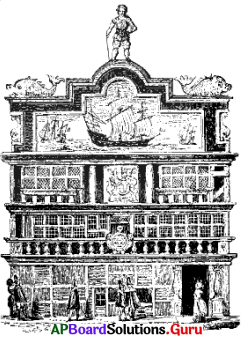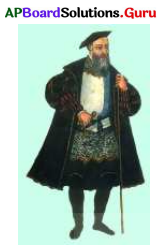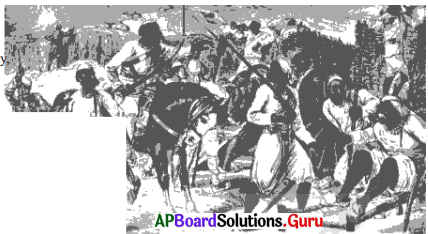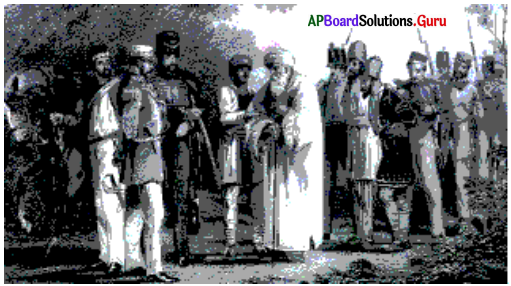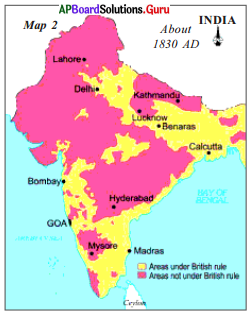Practice the AP 6th Class Social Bits with Answers Chapter 2 Globe – Model of the Earth on a regular basis so that you can attempt exams with utmost confidence.
AP State Syllabus 6th Class Social Bits 2nd Lesson Globe – Model of the Earth with Answers
Choose the correct answer.
Question 1.
A globe is the
A) Model of the Mars
B) Model of the Earth
C) Model of the Jupiter
D) Model of the Saturn
Answer:
B) Model of the Earth
Question 2.
A globe shows the
A) The shape of the Earth
B) Water and Masses
C) Oceans
D) All the above
Answer:
D) All the above
![]()
Question 3.
The total number of latitudes in both the hemispheres is
A) 90
B) 100
C) 180
D) 360
Answer:
C) 180
Question 4.
The globe and the earth are different in
A) shape
B) size
C) continents and oceans
D) None of these
Answer:
B) size
Question 5.
The longest latitude
A) Tropic of Cancer
B) Tropic of Capricorn
C) Equator
D) Arctic circle
Answer:
C) the Equator
Question 6.
The imaginary horizontal lines on the globe are ……………….
A) latitudes
B) longitudes
C) parallels
D) both A & C
Answer:
A) latitudes
![]()
Question 7.
The hemisphere that lies between the Equator and the North pole is ……………….
A) Southern hemisphere
B) Northern hemisphere
C) Eastern hemisphere
D) Western Hemisphere
Answer:
B) Northern hemisphere
Question 8.
The hemisphere that lies between the Equator and the South pole is ……………….
A) Southern hemisphere
B) Northern hemisphere
G) Eastern hemisphere
D) Western Hemisphere
Answer:
A) Southern hemisphere
Question 9.
India is located in ……………….
A) Northern hemisphere
B) Eastern hemisphere
C) Southern hemisphere
D) Both A & B
Answer:
D) Both A & B
Question 10.
An imaginary line that connects the North and South poles on the earth is called
A) Latitude
B) Longitude
C) Axis
D) Orbit
Answer:
B) Longitude
![]()
Question 11.
The other name of 0° longitude ……………….
A) Greenwich longitude
B) The longest longitude
C) 180° western longitude
D) All the above
Answer:
A) Greenwich longitude
Question 12.
The value of the Prime meridian is
A) 90°
B) 0°
C) 60°
D) 180°
Answer:
B) 0°
Question 13.
The Antarctic Circle is located in
A) 6654° N
B) 2354° S
C) 2354° N
D) 6654° S
Answer:
D) 6654° S
Question 14.
The Antarctic Circle is located in
A) the Northern hemisphere
B) the Southern Hemisphere
C) the Eastern Hemisphere
D) the Western Hemisphere
Answer:
B) the Southern Hemisphere
![]()
Question 15.
The Tropic of Cancer is located at
A) 2354° N
B) 6654°N
C) 2354° S
D) 6654° S
Answer:
A) 2354° N
Question 16.
The Earth moves at a speed of
A) 1610 KMPH
B) 1160 KMPH
C) 1810 KMPH
D) 1060 KMPH
Answer:
A) 1610 KMPH
Question 17.
The Earth moves on its own axis from
A) West to East
B) East to West
C) North to East
D) South to North
Answer:
A) West to East
Question 18.
A: The globe moves around the axis from East to West.
B: The imaginary line which runs horizontally on the globe divides it into two equal halves.
A) A is correct
B) B is correct
C) Both A & B are correct
D) Both A & B are wrong
Answer:
B) B is correct
![]()
Question 19.
A: the Equator is 0° latitude.
B: India is located in the Southern hemisphere.
A) A is correct
B) B is correct
C) Both A and B are correct
D) Both A and B are wrong
Answer:
A) A is correct
Question 20.
A: Latitudes are parallel to each other.
B: Latitudes are equal in length.
A) A is correct
B) B is correct
C) Both A and B are correct
D) Both A and B are wrong
Answer:
A) A is correct
Question 21.
A: Longitudes run parallel to the equator.
B: Longitudes never meet.
A) A is correct
B) B is correct
C) Both A and B are correct
D) Both A and B are wrong
Answer:
D) Both A and B are wrong
Question 22.
A: Planets rotate themselves while revolving around the Sun.
B: Earth’s movement from West to East is called rotation.
A) A is correct
B) B is correct
C) Both A and B are correct
D) Both A and B are wrong
Answer:
C) Both A and B are correct
![]()
Question 23.
Arrange the latitudes from South to North.
Antarctic Circle, Tropic of Capricorn, Tropic of Cancer, Arctic Circle, Equator
A) Arctic Circle, Tropic of Capricorn, Equator, Tropic of Cancer, Antarctic Circle
B) Antarctic Circle, Tropic of Capricorn, Equator, Tropic of Cancer, Arctic Circle
C) Antarctic Circle, Tropic of Capricorn, Tropic of Cancer, Equator, Antarctic Circle
D) Antarctic Circle, Arctic Circle, Tropic of Capricorn, Equator, Tropic of Cancer
Answer:
B) Antarctic Circle, Tropic of Capricorn, Equator, Tropic of Cancer, Arctic Circle
Question 24.
Match the following.,
1) Longitudes a) Prime Meridian
2) 0° Latitude b) Tropic of Cancer
3) 23[latex]\frac{1}{2}[/latex]° North latitude c) Antarctic Circle
4) 0° longitude d) Meridians
5) 66[latex]\frac{1}{2}[/latex]° South latitude e) Equator
A) 1 – c, 2 – d, 3 – b, 4 – a, 5 – e
B) 1 – d, 2 – a, 3 – b, 4 – e, 5 – c
C) 1 – d, 2 – e, 3 – b, 4 – a, 5 – c
D) 1 – d, 2 – c, 3 – b, 4 – a, 5 – e
Answer:
C) 1 – d, 2 – e, 3 – b, 4 – a, 5 – c
Question 25.
Choose the wrong statement.
1) Solar eclipse – when Earth comes in between the Sun and Moon
2) Lunar Eclipse – when Earth comes in between the Sun and the moon
3) Earth’s Rotation – Earth’s movement around itself
4) Earth’s revolution – Earth’s movement around the Sun
A) 1 B) 2 C) 3 D) 4
Answer:
A) 1
![]()
Question 26.
Sun’s rays fall directly on the Earth on
A) 21st June and 22nd December
B) 21st March and 22nd December
C) 21st March and 23rd September
D) 21st June and 23rd September
Answer:
C) 21st March and 23rd September
Question 27.
Christmas is celebrated in summer in Australia due to
A) Earth’s rotation
B) Earth’s revolution
C) Moon’s rotation
D) Moon’s revolution
Answer:
B) Earth’s revolution
Question 28.
Match the following.
1) Earth’s rotation a) 0° longitude
2) Earth’s revolution b) 23[latex]\frac{1}{2}[/latex]° North latitude
3) International date line c) Day and night
4) Tropic of Cancer d) 23[latex]\frac{1}{2}[/latex]° South latitude
5) Tropic of Capricorn e) Seasons
6) Greenwich line f) 180° East and west longitude
A) 1 – c, 2 – e, 3 – d, 4 – a, 5 – b, 6 – f
B) 1 – c, 2 – b, 3 – a, 4 – f, 5 – e, 6 – d
C) 1 – c, 2 – e, 3 – f, 4 – b, 5 – d, 6 – a
D) 1 – d, 2 – b, 3 – e, 4 – f, 5 – c, 6 – a
Answer:
C) 1 – c, 2 – e, 3 – f, 4 – b, 5 – d, 6 – a
![]()
Question 29.
India is located in
A) Northern Hemisphere
B) Southern Hemisphere
C) Both Southern and Western Hemisphere
D) Both Northern and Eastern Hemisphere
Answer:
D) Both Northern and Eastern Hemisphere
Question 30.
A: Europe and the Arctic Ocean are in Northern Hemisphere.
B: Australia and the Southern Ocean are in Southern Hemisphere.
A) A is correct
B) B is correct
C) Both A and B are correct
D) Both A and B are wrong
Answer:
C) Both A and B are correct
Fill in the blanks.
1. The ocean on both sides of a world map ……………….
Answer:
Pacific Ocean
2. The word Globe came from …………….. language.
Answer:
Latin
3. The Globe is a true model of the …………….
Answer:
Earth
![]()
4. The needle fixed through the globe is called ……………….
Answer:
Axis
5. The oldest terrestrial globe was made in ………………..
Answer:
1492
6. The world’s first seamless celestial globe was built by Mughal scientists under the patronage during ……………… empire.
Answer:
Mughal
7. The horizontal imaginary line that divides the globe into two equal halves is ………………
Answer:
the Equator
8. The halve that lies north of the Equator is known as ……………….
Answer:
Northern Hemisphere
9. The halve that lies south of the Equator is known as ……………….
Answer:
Southern Hemisphere
10. The horizontal lines drawn parallel to the Equator are ……………….
Answer:
latitudes
![]()
11. The 90° latitude that lies to the north Of the Equator ……………….
Answer:
North Pole
12. The 90° latitude that lies to the south of the Equator ……………….
Answer:
South Pole
13. The Tropic of Capricorn is located at ……………….
Answer:
231/2° S
14. The imaginary lines drawn perpendicular to the latitudes are ……………….
Answer:
longitudes
15. The 0° Meridian is also known as ……………….
Answer:
Prime Meridian/Greenwich
16. The line opposite Greenwich is called ……………….
Answer:
International Date Line
17. The hemisphere that lies East to the Greenwich ……………….
Answer:
Eastern Hemisphere
![]()
18. The hemisphere that lies West to the Greenwich ……………….
Answer:
Western Hemisphere
19. The distance between the longitudes decreases towards ……………….
Answer:
Prime Meridian
20. The Arctic Circle is located in the ………………. hemisphere.
Answer:
Northern
21. To locate a point, we need to know its latitude, as well as ……………….
Answer:
longitude
22. Day and night are caused due to the Earth’s ……………….
Answer:
rotation
23. When half portion of the Earth receives Sun’s rays, the remaining half remains in, ……………….
Answer:
Dark
24. A leap year has ……………….
Answer:
366 Days
25. Seasons are caused due to the Earth’s ……………….
Answer:
revolution
![]()
26. When Sun, Moon and the Earth comes into a straight line ……………….
Answer:
Solar eclipse
Match the following:
Column A Column B
1) Globe ( ) A) Sun, Earth, Moon comes into one line
2) Seasons ( ) B) Sun, Moon, Earth comes into one line
3) Day and night ( ) C) 90° Northernmost part of the earth
4) Solar eclipse ( ) D) Model of the earth
5) Lunar eclipse ( ) E) 66VS° North latitude
6) Arctic circle ( ) F) 90° Southernmost part of the earth
7) South Pole ( ) G) Rotation of the earth
– H) 6614° North latitude
– I) Revolution of Earth
Answer:
1 – D
2 – I
3 – G
4 – B
5 – A
6 – E
7 – F

